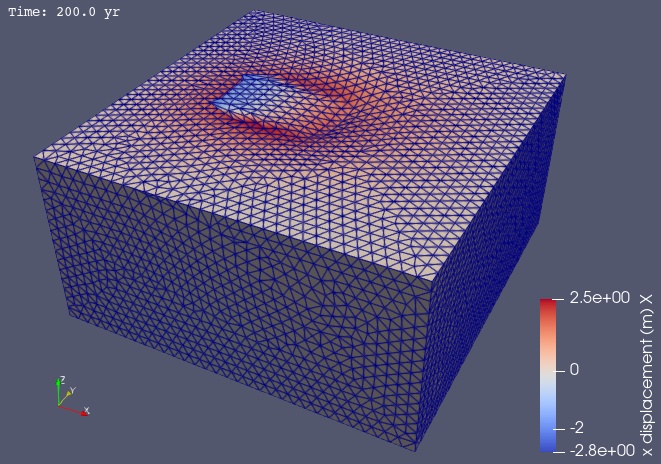Step 2: Earthquake Rupture and Postseismic Relaxation#
This example involves a quasi-static simulation for coseismic earthquake rupture and postseismic relaxation. We use linear Maxwell viscoelastic bulk rheologies in the mantle and deeper part of the slab. Fig. 102 shows the boundary conditions on the domain.
Fig. 102 Boundary conditions for quasi-static coseismic slip on the subduction interface and postseismic relaxation. We prescribe uniform oblique slip in the center of the subduction interfaces with roller boundary conditions on the lateral sides and bottom of the domain.#
Features
Tetrahedral cells
pylith.meshio.MeshIOCubit
pylith.problems.TimeDependent
pylith.meshio.OutputSolnBoundary
pylith.meshio.DataWriterHDF5
pylith.bc.DirichletTimeDependent
pylith.bc.ZeroDB
spatialdata.geocoords.CSGeo
pylith.materials.Elasticity
pylith.materials.IsotropicLinearElasticity
pylith.materials.IsotropicLinearMaxwell
spatialdata.spatialdb.CompositeDB
spatialdata.spatialdb.SimpleDB
spatialdata.spatialdb.SimpleGridDB
Quasi-static simulation
pylith.faults.KinSrcStep
Simulation parameters#
The parameters specific to this example are in step02_coseismic.cfg and include:
pylithapp.metadataMetadata for this simulation. Even when the author and version are the same for all simulations in a directory, we prefer to keep that metadata in each simulation file as a reminder to keep it up-to-date for each simulation.pylithappParameters defining where to write the output.pylithapp.problemParameters for the solution field with displacement and Lagrange multiplier subfields.pylithapp.interfacesParameters for the earthquake rupture.
We define the duration of the simulation to be 200 years with an initial time step of 10 years. Using the default time stepping algorithm (backward Euler), the time step will remain uniform. Some of the other algorithms adapt the time step to the solution.
For the fault slip, we use the nodesets for the fault and its buried edges corresponding to the central patch of the top of the slab.
We set the initiation time to 10 years with the default step time function for the earthquake rupture.
We could have also set the origin_time of the earthquake rupture to 10 years and used an initiation_time of 0 years.
We impose oblique slip with 1.0 m of right-lateral slip and 4.0 m of reverse slip.
$ pylith step02_coseismic.cfg mat_viscoelastic.cfg
# The output should look something like the following.
>> /software/py38-venv/pylith-opt/lib/python3.8/site-packages/pylith/meshio/MeshIOObj.py:44:read
-- meshiocubit(info)
-- Reading finite-element mesh
>> /pylith/libsrc/pylith/meshio/MeshIOCubit.cc:157:void pylith::meshio::MeshIOCubit::_readVertices(pylith::meshio::ExodusII&,
pylith::scalar_array*, int*, int*) const
-- meshiocubit(info)
-- Component 'reader': Reading 24824 vertices.
>> /pylith/libsrc/pylith/meshio/MeshIOCubit.cc:217:void pylith::meshio::MeshIOCubit::_readCells(pylith::meshio::ExodusII&, pyl
ith::int_array*, pylith::int_array*, int*, int*) const
-- meshiocubit(info)
-- Component 'reader': Reading 134381 cells in 4 blocks.
# -- many lines omitted --
>> /pylith/libsrc/pylith/utils/PetscOptions.cc:235:static void pylith::utils::_PetscOptions::write(pythia::journal::info_t&, const char*, const pylith::utils::PetscOptions&)
-- petscoptions(info)
-- Setting PETSc options:
fieldsplit_displacement_ksp_type = preonly
fieldsplit_displacement_mg_levels_ksp_type = richardson
fieldsplit_displacement_mg_levels_pc_type = sor
fieldsplit_displacement_pc_type = gamg
fieldsplit_lagrange_multiplier_fault_ksp_type = preonly
fieldsplit_lagrange_multiplier_fault_mg_levels_ksp_type = richardson
fieldsplit_lagrange_multiplier_fault_mg_levels_pc_type = sor
fieldsplit_lagrange_multiplier_fault_pc_type = gamg
ksp_atol = 1.0e-12
ksp_converged_reason = true
ksp_error_if_not_converged = true
ksp_rtol = 1.0e-12
pc_fieldsplit_schur_factorization_type = lower
pc_fieldsplit_schur_precondition = selfp
pc_fieldsplit_schur_scale = 1.0
pc_fieldsplit_type = schur
pc_type = fieldsplit
pc_use_amat = true
snes_atol = 1.0e-9
snes_converged_reason = true
snes_error_if_not_converged = true
snes_monitor = true
snes_rtol = 1.0e-12
ts_error_if_step_fails = true
ts_monitor = true
ts_type = beuler
# -- many lines omitted --
20 TS dt 0.1 time 1.9
0 SNES Function norm 2.013038975343e-02
Linear solve converged due to CONVERGED_ATOL iterations 50
1 SNES Function norm 3.127115384896e-10
Nonlinear solve converged due to CONVERGED_FNORM_ABS iterations 1
21 TS dt 0.1 time 2.
>> /software/py38-venv/pylith-opt/lib/python3.8/site-packages/pylith/problems/Problem.py:201:finalize
-- timedependent(info)
-- Finalizing problem.
At the beginning of the output written to the terminal, we see that PyLith is reading the mesh using the MeshIOCubit reader.
We also see the PETSc solver options, which show use of the Schur preconditioner and GAMG (algebriac multigrid) for the displacement and fault Lagrange multiplier solution subfields.
At the end of the output written to the terminal, we see that the solver advanced the solution 21 time steps.
The linear solve converged after 50 iterations and the norm of the residual met the absolute convergence tolerance (ksp_atol) .
The nonlinear solve converged in 1 iteration, which we expect because this is a linear problem, and the residual met the absolute convergence tolerance (snes_atol).
Visualizing the results#
The output directory contains the simulation output.
Each “observer” writes its own set of files, so the solution over the domain is in one set of files, the boundary condition information is in another set of files, and the material information is in yet another set of files.
The HDF5 (.h5) files contain the mesh geometry and topology information along with the solution fields.
The Xdmf (.xmf) files contain metadata that allow visualization tools like ParaView to know where to find the information in the HDF5 files.
To visualize the data using ParaView or Visit, load the Xdmf files.
In Fig. 103 we use ParaView to visualize the x displacement field using the viz/plot_dispwarp.py Python script.
We start ParaView from the examples/subduction-3d directory and then run the viz/plot_dispwarp.py Python script as described in ParaView Python Scripts.

Fig. 103 Solution for Step 2. The colors of the shaded surface indicate the magnitude of the x displacement, and the deformation is exaggerated by a factor of 1000.#
